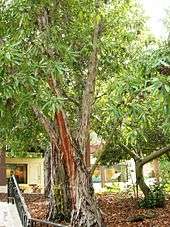Lyonothamnus
| Lyonothamnus | |
|---|---|
 | |
| L. floribundus ssp. aspleniifolius leaf | |
| Scientific classification | |
| Kingdom: | Plantae |
| (unranked): | Angiosperms |
| (unranked): | Eudicots |
| (unranked): | Rosids |
| Order: | Rosales |
| Family: | Rosaceae |
| Subfamily: | Amygdaloideae[1] |
| Genus: | Lyonothamnus |
| Species: | L. floribundus |
| Binomial name | |
| Lyonothamnus floribundus A.Gray | |
| Subspecies | |
| |
Lyonothamnus is a monotypic genus of trees in the rose family containing the single living species Lyonothamnus floribundus, which is known by the common name Catalina ironwood, and the subspecies L. f. ssp. aspleniifolius and L. f. ssp. floribundus.
Description
Lyonothamnus is endemic to the Channel Islands of California, where it grows in the chaparral and oak woodlands of the rocky coastal canyons.
This is a tree growing up to 15 metres (49 ft) tall with peeling reddish gray or brown bark. The evergreen leaves are shiny, dark green with lighter undersides, and borne on short petioles. The two subspecies have leaves of different leaf shapes. The inflorescence is a cluster of woolly white flowers with many short, whiskery stamens. The fruit is a pair of hard follicles.
Systematics
Lyonothamnus is currently a geographically restricted island endemic genus containing one species with two subspecies. Discoveries of fossils have suggested that the genus once comprised several species, all but one now extinct, which grew on the mainland in the southwestern United States.[2]

Subspecies
There are two subspecies which are different in morphology.
- ssp. aspleniifolius is the more common, and has leaves made up of linear leaflets which are divided into rectangular segments.
- ssp. floribundus is limited to Catalina Island, has smooth-edged leaves not divided into any leaflets or segments.
Cultivation
The Lyonothamnus ssp. aspleniifolius tree is grown in the horticulture nursery trade and used in landscape design; in drought tolerant, California native plants, traditional, and habitat-wildlife gardens; in public landscapes and private garden settings.[3]

See also
References
- ↑ Potter, D., et al. (2007). Phylogeny and classification of Rosaceae. Plant Systematics and Evolution. 266(1–2): 5–43. [Referring to the subfamily by the name "Spiraeoideae"]
- ↑ Erwin, D. M. & Schorn, H. E. (2000). "Revision of Lyonothamnus A.Gray (Rosaceae) from the Neogene of Western North America". International Journal of Plant Sciences. 161 (1): 179–193. doi:10.1086/314232.
- ↑ Bornstein, Carol; Fross, David; & O,Brien, Bart. "California Native Plants for the Garden'. Cachuma Press, Los Olivos, CA. 2005. p.131.
External links
| Wikimedia Commons has media related to Lyonothamnus. |